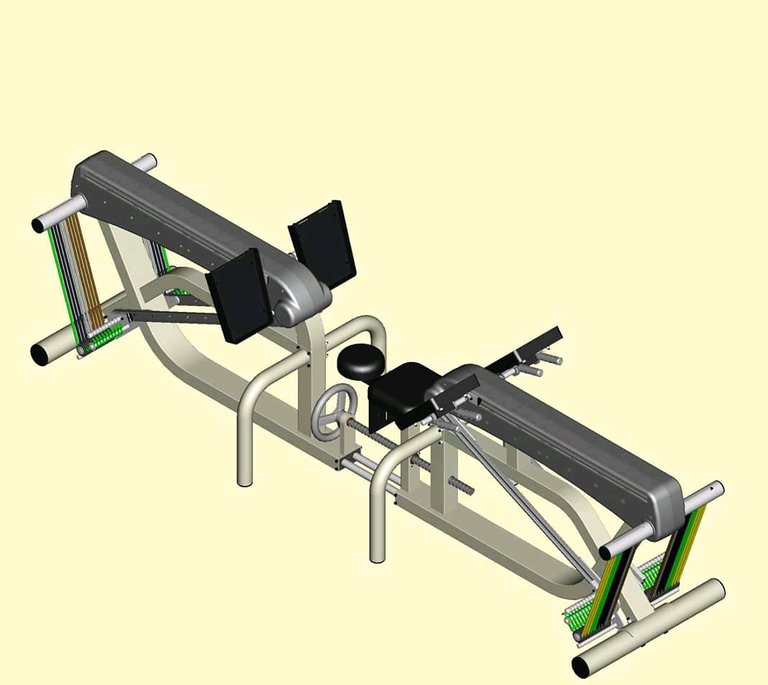
A healthy body, is the fastest route to a healthy mind and soul, healthy living is a product of a healthy body and a healthy mind, hence a healthy body is paramount.Permit me to say that I’ve lost track of the philosopher who said this… lol, but as a matter of fact, his claim is the closest thing to perfection. Keeping a fit body is thus a vital aspect of our everyday life, and despite our very tight schedules we struggle hard to make out time and exercise our body tissues, organs and system.
While we perceive these activities as just exercising the MUSCLES, it goes far beyond this and extends to our internal organs and the body system, and just as the introductory quote rightfully said, a healthy body begets a healthy mind and soul, body exercises also strengthens our mind, arguably anyways, but our Yoga team can always testify to this fact, flexibility is not just a physical phenomenon, it is also an attitude.
Very popular ways of keeping fit includes, jogging, weight lifting, and body workouts, however, science has rightfully singled out Cycling as the most complete exercise, cycling movements and the feelings serves a good exercise for the body and keeps the soul fit and clear.
Unfortunately, our tight daily schedules doesn’t always afford us the right amount of time to cycle the streets as much as is required to keep fit, hence we seek alternatives to this, machines which provides a run way replica with zero friction have been in use for a very long time, and also the immovable cycles have been a big part of out indoor exercise, this have served so well, and yet another addition to our indoor exercise equipment, The FISH AND KANGAROO MACHINE popularly known as FKM, the Fish and Kangaroo machine was developed by James Young, US Military Non-Commissioned officer, Professional MMA fighter, and body fitness expert in a bid to produce a better effect than our everyday Bi-cyles in indoor exercise.
Mechanism of The Fish and kangaroo machine
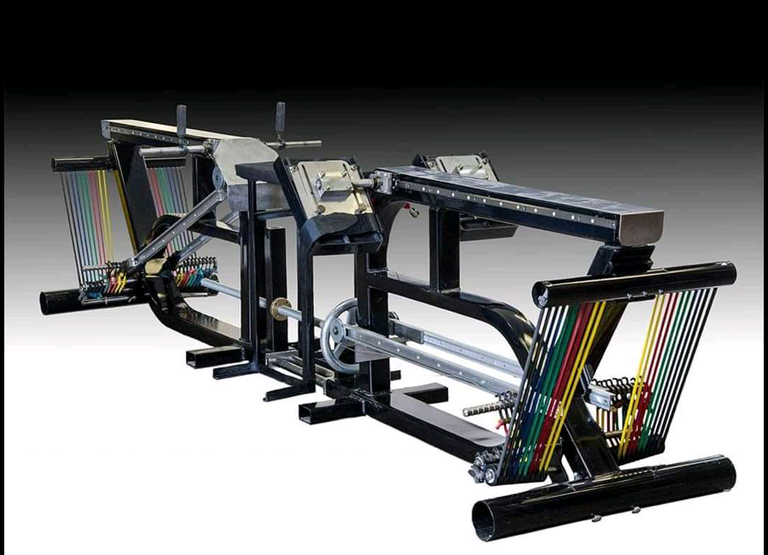
The glycolytic pathway, the Krebs cycle and the Cori cycle explains the route taken by the enzymatic system in an attempt to metabolize the body’s food store and produce energy in the form of ATP (The cellular energy currency). The state of the body and also the body’s exposure to triggers of metabolism such as starvation and oxygen respectively, determines the route and rate of metabolism. With respect to exercise, the intensity and duration of the exercise is the major determinant of the route of metabolism as the body’s supply of oxygen also varies with these factors (duration and intensity of the exercise).
During short-lived and highly intense exercise such as cycling at your maximum speed and acceleration, the body system switches to an anaerobic pathway of metabolism as there is a pronounced oxygen deficit which favours the anaerobic pathway, popularly known as the Cori cycle, with the production of lactic acid in glucose metabolism, on the contrast, long duration exercise with low intensity allows the body get the required amount of oxygen for anaerobic metabolism.
The fish and kangaroo machine allows for simultaneous arm and leg motion while the user lies in a prone position and hence provides a similar scenario with the use of bicycles and hence a relationship in metabolism while using these two machines in a similar way (intensity and duration)
Machine design and test procedure
Currently in beta testing phase, the Fish and kangaroo machine was designed to allow the user a relatively arm and leg motion while lying in a prone position with variable resistance to motion controlled by a band system. The band system provides a range of resistance from 3lbs to 50lbs. For high level athletes the starting resistance is about 10 lbs for a 3 minute duration before failure, hence enough strength is required from the user.
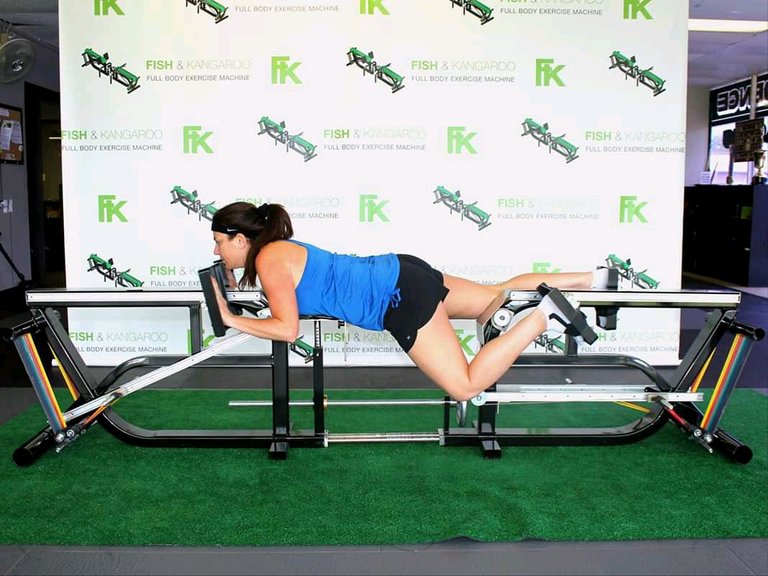
To perform the supervised test, ten (10) physically active adults (4men and 6women) were recruited and monitored as they undergo routine usage of the FK machine, parameters such as Heart rate (HR), Blood lactate, Oxygen consumption (VO2), Ventilation and energy expenditure (EE) were measured over a period of forty-two (42) minutes; with one minute intense exercise and four minutes recovery period (rest), hence the machine was designed for anaerobic exercise (high intensity, short duration).
Parameters measurement and results
Respiratory parameters: Mixed expired air collected from the users during the test time were analysed using an automated metabolic cart to determine the oxygen consumption (VO2), respiratory exchange ratio (RER), Ventilation (VE) and energy expenditure (EE), a rise on the values of these parameters in comparison with the peak response of the first exercise interval was recorded, the percentage rise for each parameters are as follows:
Oxygen consumption (VO2) : 13%
Ventilation(VE): 17%
Energy expenditure (EE) : 20%
Respiratory exchange ratio: No reasonable change
These rise in values during the exercise interval returned to normal rest values after the recovery period (4minutes)
The FK machine recorded no shift in the normal carbohydrate to fat utilization during exercise.
Heart rate: The heart rate was monitored via telemetry and a 13% increase in the heart rate from peak response of the first exercise interval till the peak response of the sixth (6th) exercise interval was recorded.
Blood lactate: Blood was collected from the finger tips of each user after each exercise interval and ten minutes after the completion of the test and measurement of the blood lactate was made using a handheld analyzer; a fifty percent (50%) increase in the blood lactate was recorded between the peak of the first exercise interval and the peak of the sixth exercise interval. This was expected as the FKM was designed to provide anaerobic exercise means.
Comparing the test results of the FKM with the results obtained while using a bicycle
The following were observed when the results obtained during the testing of the Fish and kangaroo machine was compared with the already existing results obtained during exercise with a bicycle.
cardiovascular functions
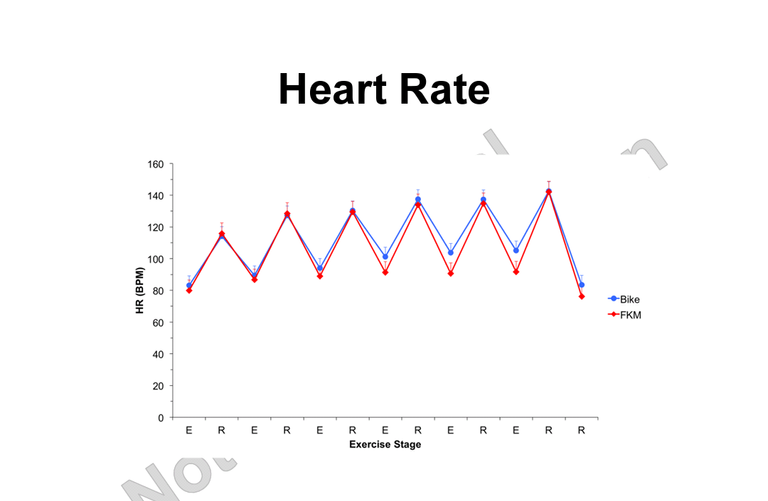
Heart rate: The heart rate (in Beats/min) were uniform for the FKM and the bicycle during the exercise period, however, the rest values for the FKM showed a slight decrease in comparison with the bicycle.
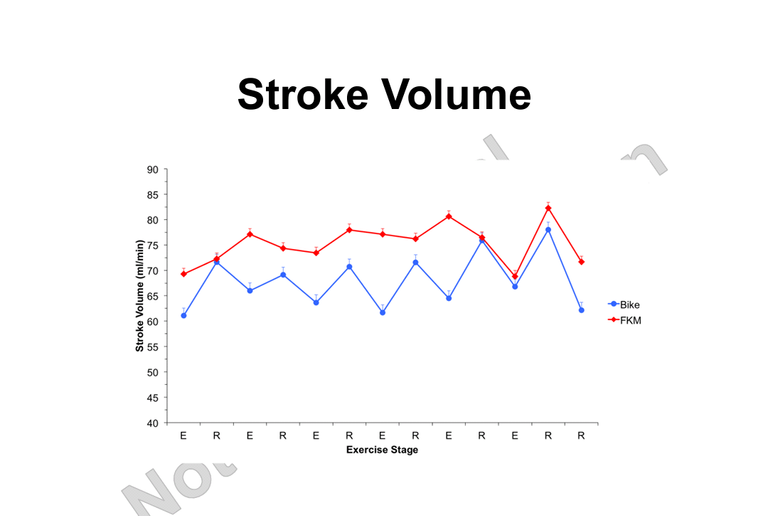
Stroke volume: The FKM machine showed a higher stroke volume which was maintained during the rest periods.
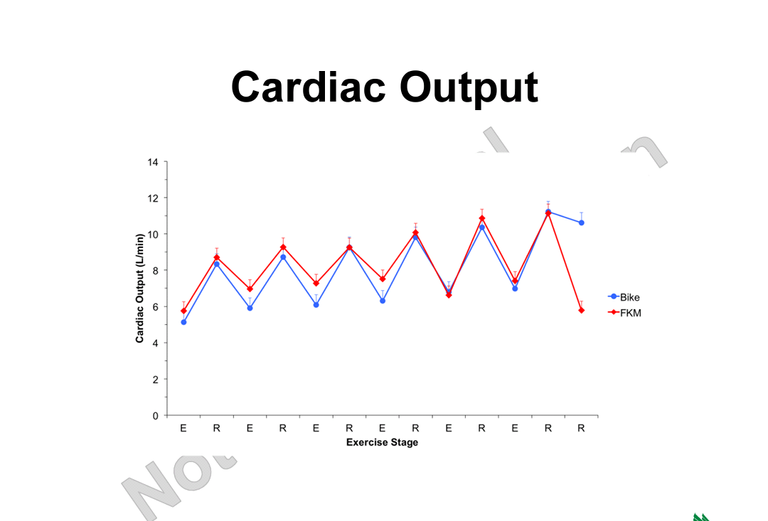
cardiac output: The FKM recorded a better cardiac output recovery at the end of the exercise.
Respiratory parameters
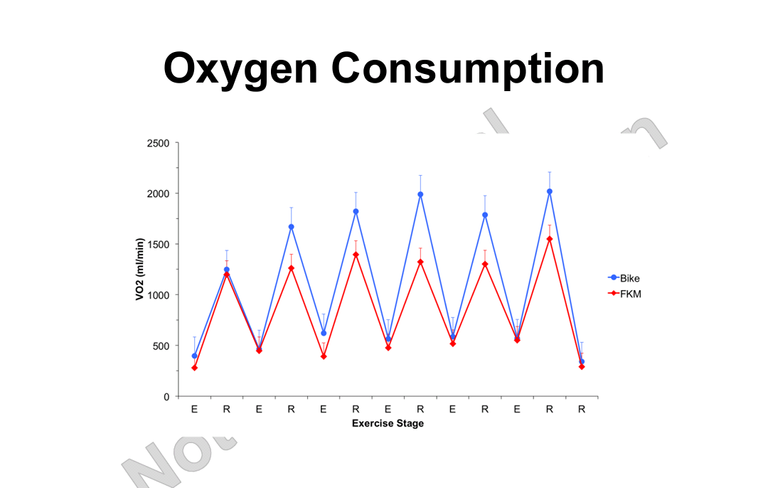
Oxygen consumption: Oxygen consumption when using the FKM was approximately similar with the values for a bicycle at the onset (for exercise and rest stages), however, oxygen consumption values during the exercise stage for a bicycle spiked over the values for FKM, this is acceptable and in line with the goals of an anaerobic exercise machine.
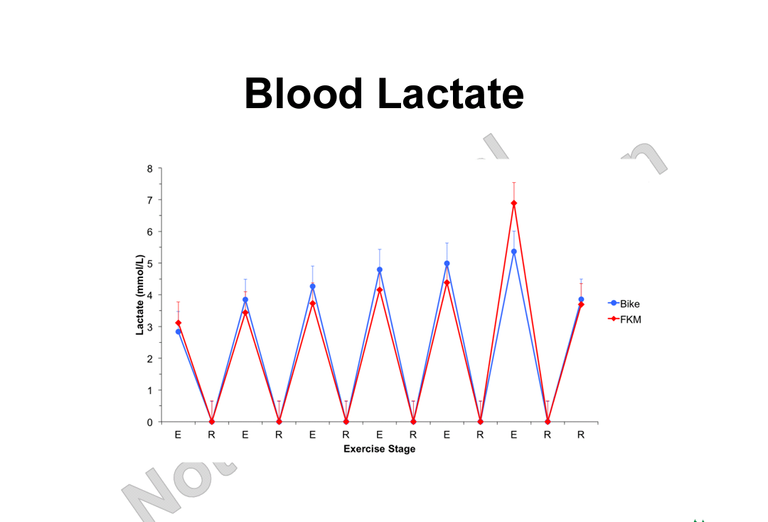
Blood lactate: A noticeable peak in the value of the blood lactate while using the FKM in comparison with that obtained using the bicycle was recorded at the highest work load, this is due to the relatively lesser oxygen consumption while using the FKM.
Significance of results
For cardiovascular functions
Higher stroke volume could contribute to a better lactate clearance from the muscles and a better cardiac output recovery at the end of the exercise using the Fish and kangaroo machine restores the stretch of the cardiac muscles and makes for healthier cardiac muscle system.
For respiratory parameters: Lower oxygen consumption and higher blood lactate at maximum workload suggests a greater anaerobic activity which is expected of the FKM and confirms the clearance of lactic acid from the muscles.
Why anaerobic training?
One of the main aims of routine exercises and body workouts for mere fitness or professional purposes is to increase the body’s endurance, this can be termed a ride against muscle fatigue, however, the main cause of muscle fatigue is the accumulation of lactic acid in the muscles. This is experienced during intense exercise as the body runs short of oxygen to continue aerobic metabolism.
This accumulation of lactic acid starts when exercising above the lactate threshold, this is known as the Lactate Inflection Point; here the blood concentration of lactate and lactic acid as well begins to increase exponentially, the body produces excess lactate which cannot be completely broken down by the liver via the Cori cycle, these excess lactate are channeled to the blood, causing an increase in the blood lactate concentration.
However, endurance trainings are focused on conditioning the body muscles to adapt and prevent this rise in lactate production, endurance exercises helps to activate the PGC-1α which alters the isoenzyme composition of the lactate dehydrogenase complex and decreases the activity of the lactate dehydrogenase which generated lactic acid, this causes an overall increase in the lactate threshold and hence, the muscles can thrive well during intense and long lasting exercises, without producing much lactic acid and also breaking down higher concentration of lactic acid, and thus taking a longer time before the muscles get fatigued.
Interval trainings are one of the best ways to to improve lactate tolerance, this is achieved by exposing the body to intense exercise and a resultant intense anaerobic metabolic activity for a short duration and then allow it to recover, just as demonstrated with the Fish and kangaroo machine , this causes a temporal excess of the lactate threshold, routine performance of such activities adjust the body’s lactate threshold and hence improves lactate production, tolerance and clearance, the trainee this becomes more enduring during muscular activities.
This is the goal of the Fish and kangaroo machine (FKM) and the experiment and its results shows it to work just well according to the interval training provisions as a means of increasing individual endurance during muscular activities.
REFERENCES
Images and data in this post were reproduced with the explicit permission of the the copyright holder
All resources obtained from the Fish and kangaroo machine experiment were supplied by James Young, the inventor of the Fish and Kangaroo machine
Experimental values and comparison graphs were produced by McFarlin, BK (PHD, FASCM), University of North Texas, applied physiology Laboratory, Denton
The Fish and Kangaroo Machine is still in its production and testing phase, hence values may vary after final production
Hello! I find your post valuable for the wafrica community! Thanks for the great post! We encourage and support quality contents and projects from the West African region.
Do you have a suggestion, concern or want to appear as a guest author on WAfrica, join our discord server and discuss with a member of our curation team.
Don't forget to join us every Sunday by 20:30GMT for our Sunday WAFRO party on our discord channel. Thank you.
Thanks for using eSteem!
Your post has been voted as a part of eSteem encouragement program. Keep up the good work! Install Android, iOS Mobile app or Windows, Mac, Linux Surfer app, if you haven't already!
Learn more: https://esteem.app Join our discord: https://discord.gg/8eHupPq
CONGRATULATIONS....
Nice Job. 👍 YOUR AWESOME POST WAS SELCECTED IN THE @wafrica DAILY CURATION COURTESY: @julietisrael
Congratulations! Your post has been selected as a daily Steemit truffle! It is listed on rank 25 of all contributions awarded today. You can find the TOP DAILY TRUFFLE PICKS HERE.
I upvoted your contribution because to my mind your post is at least 7 SBD worth and should receive 262 votes. It's now up to the lovely Steemit community to make this come true.
I am
TrufflePig, an Artificial Intelligence Bot that helps minnows and content curators using Machine Learning. If you are curious how I select content, you can find an explanation here!Have a nice day and sincerely yours,

TrufflePigThis post has been voted on by the SteemSTEM curation team and voting trail in collaboration with @utopian-io and @curie.
If you appreciate the work we are doing then consider voting all three projects for witness by selecting stem.witness, utopian-io and curie!
For additional information please join us on the SteemSTEM discord and to get to know the rest of the community!